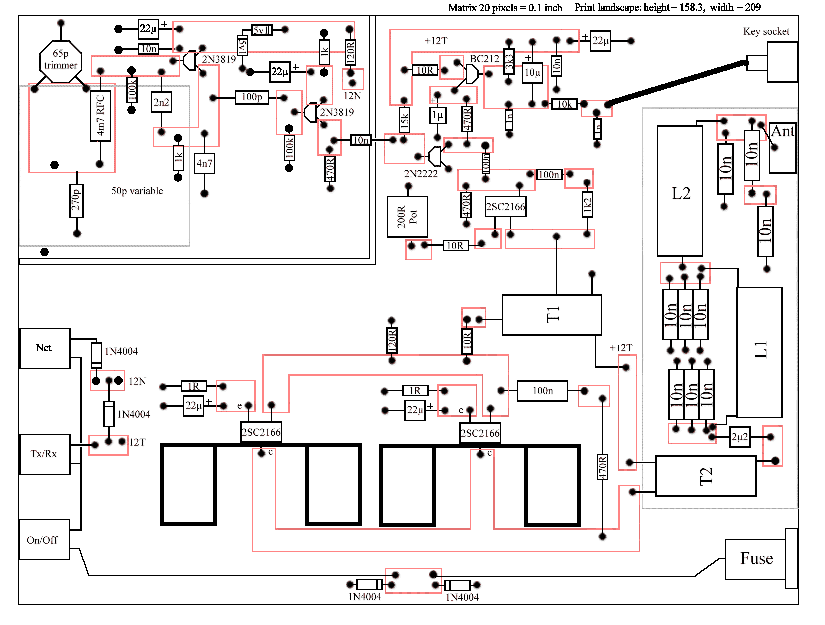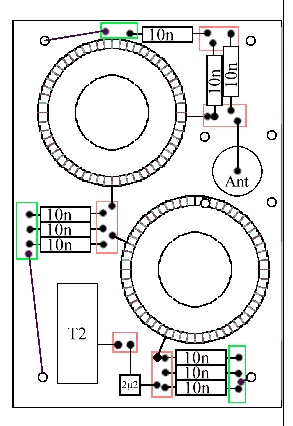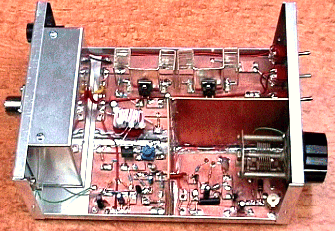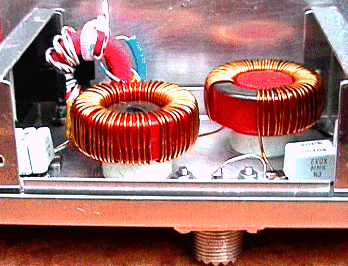
Steve kindly sent me the circuit details, but there is also plenty of information on Steve's web site at http://www.alg.demon.co.uk/radio/136/qrptx.htm.
There is not much that can be added to the info already provided by Steve, but I did construct a layout plan and used a slightly different construction method, which might be of interest to other constructors, so I include details of these here.
Steve had had some initial problems with interaction of the fields from the PA stage with the VFO and had solved these by putting the PA transformer and the filter toroids in an external pressed steel box, on the outside of the aluminium box for the rest of the circuit.
In my construction, I used a rather larger aluminium box (150x200x75 mm) and mounted another small aluminium box (100x70x40 mm) inside at the back to hold the PA transformer and filter components. Later I found (in Terman's Radio Engineering) a note to the effect that a high mu (iron) box is not necessary for magnetic field screening at RF and in fact a box made from a good conductor is actually more effective as a result of the contra-field (Lenz's law) created by the eddy currents. The Admiralty Handbook (1931 edition) says that this is true for frequencies above 15kHz.
The other feature of my construction was to use a single sided copper plated resin board as an earth plane and to glue small islands made from the same material to this plane for each of the non-earth nodes in the circuit. In addition I soldered two large square pieces of this material to the base plane and to one another to form a screen around the VFO circuitry.
I have had to reduce the resolution somewhat in order to reduce the time to load this page to an acceptable wait. If you would like full resolution images please contact me via the email address on the home page and I can send them as .gif attachments to my reply. They are constructed so that they print exactly the right size on an Epson Ink Jet printer.


I did not fit the Rx Ant socket, since I use a separate Rx antenna, but the Tx/Rx switch is still necessary.
Experience
In retrospect I should not have fitted the Net switch, since with the separate Rx antenna, no signal from the VFO is detectable.
My method of screening works well, there is no pulling of the VFO.
The 50pF tuning capacitor turned out to have more travel than needed, so I could have fitted a 30pF instead to give better bandspread.
The tuning dial is graduated from 0 to 50 using a standard dial that I created using Paint Shop Pro and printed on my Epson printer, along with all other labelling. Calibration turned out to be easy. I fitted a dummy load as Tx ant and used the Rx to tune the signal. At 5 watts to a dummy load and an outside Rx ant, the receiver is not overloaded. From these measurements I drew up a table of dial readings against frequencies and stuck it to the outside of the box.
I found I had to use the higher values of the feedback resistors as mentioned in Steve's notes in both the driver and PA stages, to suit the 2SC2166's which I got from Sycom.
Initially I had difficulty getting enough drive, but I traced this to a faulty 2N3819 in the VFO second stage. I replaced this with an MPF102 found in the junk box (be careful different pin-outs) and all was fine. For Rx I used a 200R miniature pot. I couldn't find a 250R pot from RS components, which is my main source for components (cheapest and free delivery with no lower limit).
The most interesting comment from other lowfers during QSOs, is that the signal has a nice tone and sounds very pure.
No great distance records yet, but that is not surprising since I really need to use QRO to get out from this QTH - antenna between house and hill surmounted with tall trees.
This little Tx can of course be used as input to a powerful PA. Also it occurs to me that it might not be that difficult to modify the Marathon for 160 or 80. Just the VFO and PA stages.
Some photo shots of the finished project


